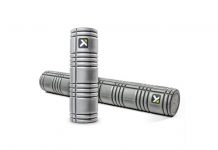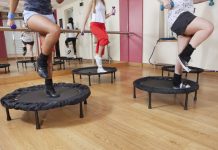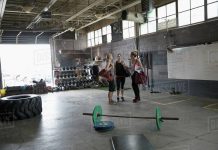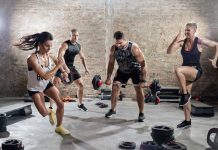
We’ll say it point blank: building muscle is a challenge. While different challenges come as you build more strength and muscle, it never gets easier. In fact, if you think muscle building is easy – you’re not working hard enough! However, just because it’s a challenge doesn’t mean you can’t make serious gains as a beginner.
Hitting the gym for the first time can be an intimidating experience, and without the proper tools, it’s all too easy to get frustrated, give up, and go home. These tips will help you navigate through some of the pitfalls and problems that plague first time muscle builders.
-
Lift Heavy
One of the best tips we can give you is to lift heavy. Like we said, muscle building is a challenge, and if you’re not making your muscles work hard, you’re not making any gains. Set numbers and repetition formulas can get complicated and be tailored for specific goals, but a general rule of thumb for a casual lifter is to aim for 3 sets of 8-12 repetitions at 70% of your maximum weight.
This means that at the end of those 8-12 reps, you should be really struggling to finish the movement. If you can easily move through your set, you need to move up to a heavier weight.
-
Use Proper Form
While lifting heavy and challenging your muscles are important for real gains, it should not come at the cost of proper form. Learning how to weight train properly will help you avoid injuries, which are the biggest detriment to your progress as injuries can take you out of the gym for long periods. Proper form also helps to target muscles properly, and allows you to lift heavier as you progress.
Especially when first learning the big, compound movements like barbell squats and deadlifts, start with a light, comfortable weight to learn what proper form should feel like. Once you’ve got a good grasp on the movements, start adding real weight to get moving on the gain-train.
-
Use Compound Movements – And Perform Them First
Compound movements are going to be your best friend for making real gains in the least amount of time. Compound movements are exercises that involve multiple joints, or multiple parts of the body, to be engaged in primary, secondary or stability functions.
These are exercises like barbell squats, deadlifts, and the dumbbell chest press. Isolation movements have their place, like for targeting muscles that only get secondary activation like biceps, but make sure to perform your compound movements first so you can lift heavier weights with your bigger muscles. Big, compound movements have also been seen to temporarily boost testosterone levels post-workout, making them more attractive for muscle and strength training. To bolster these effects even more, try using supplements like Delta Prime testo support, which help support your body’s natural testosterone production.
-
Don’t Neglect Recovery
Determined to make gains quickly, you might be tempted to hit the gym every day to annihilate your muscles with punishing workouts, with only the occasional rest day here and there. While muscle building takes commitment, it also takes adequate rest time to see real results and avoid injury.
When you lift weights and put your muscles under stress, what you’re actually doing is making miniscule tears in your muscle fibers. Your muscles get bigger and stronger when your body repairs and rebuilds these fibers. So, if you’re not giving your body the time to do this, you won’t get stronger, and risk the chance of really tearing them and hurting yourself.
Adequate rest means giving your body time between workouts as well as a decent amount of sleep. For new lifters, full body workouts 2 – 3 times a week with at least one day between sessions should be enough for you to start noticing a change in your physique. As you become stronger and more familiar with weight training, you can start working on more complicated muscle splits on consecutive workout days.
-
Listen to Your Body
Lifting heavy and challenging your muscles is the way to make them bigger, but you should never be in pain. While you should be uncomfortable and pushing yourself to get through the end of your sets, discomfort should not feel like pain.
If you’re feeling a twinge in your knee or something wrong in your back, carefully stop the movement and assess the situation. How was your form? Do you have an old injury you could have aggravated? Was the weight too heavy? Listen to your body and don’t do movements that are painful or awkward for you. Putting yourself out of the gym with an injury is the best way to lose your progress.
-
Mind Your Macros
Proper nutrition is integral to building up your muscles, as your body needs to build up and repair your muscle tissue from something! However, eating for muscle gain shouldn’t be viewed as a free pass to eat as much of whatever you please. For most, the goal is to gain muscle without gaining excess fat. This doesn’t mean you have to be on a particularly restrictive diet either. The key here is to be aware of what your body needs to build up stronger, and meet your daily goals accordingly.
Macros (short for macronutrients) are the big 3 categories that make up the diet: protein, fat, and carbohydrates. You may have heard that protein is the king of macros for bodybuilders, and it’s definitely important, but there’s no need to go overboard. Try splitting your daily intake up to get roughly 30% of your calories from protein, 30% from fat, and 40% from carbs. The carb ratio may seem high in this low-carb world, but carbs are important for providing your muscles with the energy they need to get through heavy workouts.
-
Use Variety
One of the biggest gains-killers has to be boredom. You’ve found a workout plan online that’s touted to be the best available, but you hate the exercises and by about halfway through the workout you’re bored and ready to go home. This is the easiest way to stop yourself from going to the gym.
When you’re first learning to lift it’s a great idea to use pre-made workout routines to help you hit every major muscle group and get you started on the basics, but as you get more comfortable, swap out exercises you don’t like for ones you think are interesting and will target the same muscle groups. You also make your muscles work in different ways when you add variety to your movements. For example, try targeting your upper chest by doing an incline bench press instead of on the standard flat bench.
-
Be Consistent
To get the most out of your weight training and muscle building efforts, you have to be consistent. It’s much easier to lose muscle than it is to build, and it doesn’t take long for inactivity to start eating away at your gains. This doesn’t mean that when you finally take that week of vacation you have to pump iron in Hawaii, or that eating a cheeseburger is going to immediately cover up all the work you’ve done on your abs.
Just remember that when you get back from vacation or your birthday is over, you get back to your regular workout and eating routine. This is how you make consistent and steady progress in muscle building.
-
Cardio Carefully
Cardio is often thought of as the best way to torch fat, but strength training is also highly effective as it takes more energy to maintain muscle at rest. If you’re looking to gain muscle and lose fat, simply weight training will go a long way in helping you reach that goal.
However, if you want to speed up that process or just keep up with your cardiovascular health, try working with HIIT, or high intensity interval training, instead of long distance endurance running. Endurance running can actually be detrimental to your muscle building efforts, whereas HIIT training has been seen to increase your metabolic rate for longer periods after post workout.
-
Create Goals and Measure Your Progress
It can sometimes feel like you’ve been going to the gym forever and still haven’t made any progress. These feelings are some of the biggest motivators that stop people from making serious gains. Most of us understand that results won’t be instant, but after weeks and weeks of not noticing progress it’s easy to get discouraged. The best way to avoid this and stay on track with your gains is to set smaller, measurable goals and to physically measure your progress.
Goals can be anything from upping your bench press weight 5lbs to losing 1 inch around your waist – the only criteria are you have to be able to measure them. Track your weights, measure your waist or bicep circumference, or use a piece of clothing as a gauge for your goals. This way, when you’re not able to see your gains in the mirror, you have real numbers to compare and help you assess your progress.
Also read: A detailed review of unique testosterone booster Prime Male >>


























